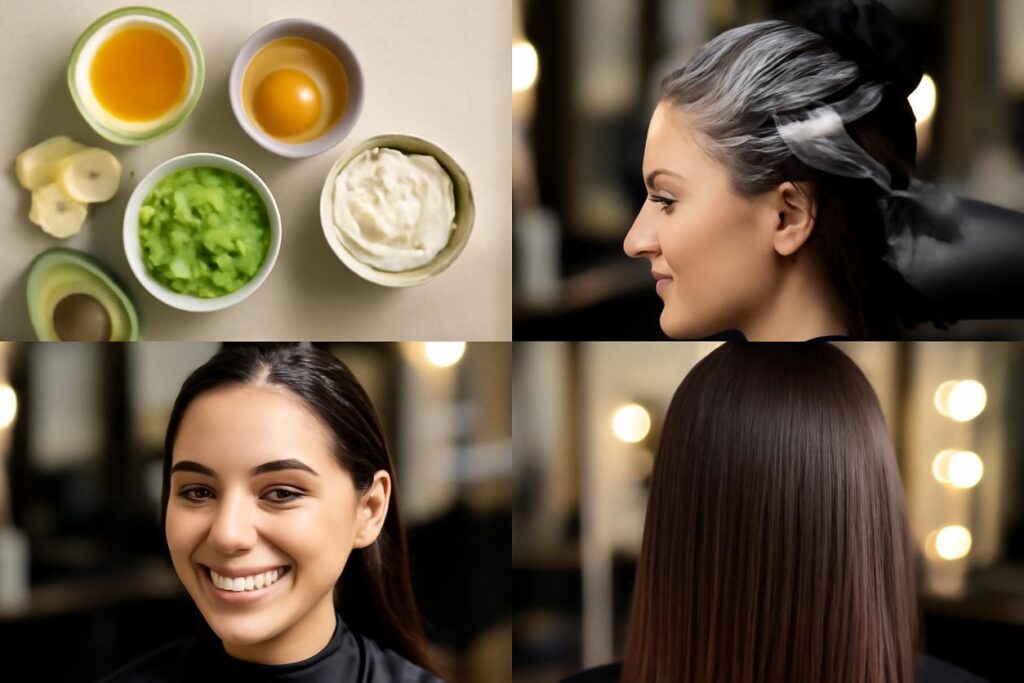Introduction: Reframing Frizz as a Manageable Trait
Frizz. For many, it’s the unpredictable, unruly halo of hair that seems to have a mind of its own. But what if we stopped seeing it as a problem and started understanding it as a signal? Frizz is simply your hair communicating its needs—usually a need for more moisture. The journey to effective frizz control isn’t about fighting your hair; it’s about learning its language and providing it with the right care and hydration. This guide will walk you through the science of frizz, practical daily routines, and smart styling strategies to help you achieve smoother, more defined, and healthier-looking hair. It’s time to embrace a new approach to managing frizz, one built on knowledge and consistent care.
What Makes Hair Become Frizzy
At its core, frizz is caused by a raised outer layer of the hair shaft, known as the cuticle. When hair is healthy and moisturized, these cuticles lie flat, creating a smooth, reflective surface. When hair is dry, damaged, or exposed to humidity, these cuticles lift, allowing moisture from the air to penetrate the hair shaft. This causes the strand to swell and contort, resulting in the fuzzy texture we call frizz. Understanding the underlying factors, like hair porosity and weather, is the first step toward successful frizz control.
Understanding Hair Porosity and Cuticle Behavior
Hair porosity refers to your hair’s ability to absorb and retain moisture. It’s largely determined by the state of your hair cuticles. There are three main types:
- Low Porosity: The cuticles are tightly packed and lie flat. This hair type is often healthy and shiny but can be resistant to moisture. Products may sit on top of the hair rather than being absorbed.
- Medium (Normal) Porosity: The cuticles are slightly raised, allowing moisture to enter and be retained easily. This is generally the easiest hair type to manage.
- High Porosity: The cuticles are widely spaced or have gaps, often due to damage from chemical treatments, heat, or genetics. This hair absorbs moisture quickly but loses it just as fast, making it highly prone to frizz and dryness.
Knowing your hair’s porosity helps you choose the right products and techniques for effective frizz control. For example, high-porosity hair needs products that both hydrate and seal the cuticle to lock moisture in.
How Humidity and Weather Affect Frizz
Humidity is the ultimate frizz trigger. Why? Because dry, porous hair is thirsty. When the air is full of moisture (high humidity), your dehydrated hair strands try to soak it up from the atmosphere. This influx of moisture causes the hair shaft to swell unevenly, disrupting the smooth cuticle layer and creating frizz. On the other hand, very dry weather (low humidity) can also be a problem, as it can strip moisture from the hair, leaving it brittle and prone to static and flyaways. A key strategy for long-term frizz control involves keeping your hair so well-hydrated that it doesn’t need to seek moisture from the air around it.
Daily Haircare Routine to Reduce Frizz
Consistency is your greatest ally in the quest for smooth hair. A daily routine focused on moisture and protection can make a significant difference. The goal is to build a foundation of hydration that supports your hair’s natural texture and resilience against environmental factors.
Shampooing and Conditioning Tips for Smoothing
The way you wash your hair sets the stage for frizz control. Over-washing can strip natural oils, leading to dryness and frizz, while using the wrong products can exacerbate the issue.
- Wash Less Frequently: Try washing your hair 2-3 times a week instead of daily. This helps preserve your scalp’s natural, moisturizing oils.
- Use Sulfate-Free Shampoos: Sulfates are harsh detergents that can strip hair of its moisture. Opt for gentle, sulfate-free formulas that cleanse without causing dryness.
- Focus on the Scalp: When shampooing, concentrate the product on your scalp where oil and dirt accumulate. Let the suds run down the lengths of your hair as you rinse, which is sufficient to clean them.
- Always Condition: Conditioner is non-negotiable for frizz management. It helps to smooth the hair cuticle, replenish moisture, and improve manageability. Apply conditioner from the mid-lengths to the ends, leaving it on for a few minutes before rinsing.
- Rinse with Cool Water: A final rinse with cool or lukewarm water helps to seal the hair cuticle, locking in moisture and boosting shine.
Leave-in Treatments and Serums Explained
Leave-in products are the secret weapon for all-day frizz control. Applied to damp hair after washing, they provide a continuous layer of moisture and protection.
- Leave-in Conditioners: These are lightweight creams or sprays that offer an extra dose of hydration and detangling power. They are especially beneficial for curly, coily, and high-porosity hair.
- Hair Serums: Typically silicone-based, serums create a protective barrier around the hair shaft. This barrier locks moisture in, keeps humidity out, and adds a beautiful, glossy finish. A little goes a long way.
- Oils: Natural oils like argan, coconut, or jojoba can be used to seal the ends of your hair and add shine. They are excellent for locking in the moisture provided by your leave-in conditioner.
Apply these products to towel-dried (not sopping wet) hair, focusing on the mid-lengths and ends where hair is most prone to dryness and frizz.
Key Ingredients That Help Control Frizz
Navigating the world of haircare ingredients can be daunting, but a few key players stand out for their ability to deliver superior frizz control. Learning to spot these on a label will empower you to make smarter choices for your hair.
- Glycerin: A powerful humectant, glycerin attracts moisture from the air into the hair shaft. It’s excellent in moderate humidity but can sometimes cause more frizz in very high humidity if not paired with sealing ingredients.
- Silicones (e.g., Dimethicone, Cyclomethicone): Often misunderstood, silicones are fantastic for frizz. They form a lightweight, water-resistant coating over the hair, sealing the cuticle, preventing moisture loss, and blocking humidity. Look for water-soluble or easily washed-out versions to avoid buildup.
- Natural Oils and Butters (Argan Oil, Shea Butter, Coconut Oil): These are emollients and occlusives. They soften the hair, fill in gaps in the cuticle, and create a physical barrier to lock in hydration.
- Hydrolyzed Proteins (Keratin, Silk, Wheat): These proteins temporarily patch damaged areas in the hair shaft, strengthening it and smoothing the cuticle.
How to Read Labels and Avoid Fillers
To truly master frizz control, become a label detective. Ingredients are listed in order of concentration. The first five ingredients make up the bulk of the formula. For an effective anti-frizz product, look for the beneficial ingredients mentioned above to be listed near the top. Be wary of products that are high in drying alcohols (like alcohol denat.) or contain an excess of simple fillers without offering real moisturizing or sealing benefits. A great resource for deeper understanding is available from experts in haircare like Rich Hair UK, who prioritize ingredient education.
Styling Methods That Seal the Cuticle
How you handle and style your hair is just as important as the products you use. The right techniques can dramatically enhance your frizz control efforts by ensuring the hair cuticle remains smooth and sealed from start to finish.
First, be gentle with wet hair. Hair is at its most fragile when wet. Instead of rubbing vigorously with a rough towel, gently squeeze out excess water with a microfiber towel or an old t-shirt. This prevents friction that can rough up the cuticle. When detangling, use a wide-tooth comb and start from the ends, working your way up to the roots to minimize breakage.
Tools and Heat Techniques with Minimal Frizz Risk
Heat styling can be a major contributor to frizz if not done correctly. However, when used strategically, it can also be a powerful tool for sealing the cuticle and achieving a smooth finish.
- Always Use a Heat Protectant: This is a non-negotiable step. A good heat protectant creates a barrier between your hair and the tool, preventing moisture loss and damage.
- Choose Ionic Tools: Hair dryers, flat irons, and curling wands with ionic technology emit negative ions that help break down water molecules faster. This means less drying time and less heat exposure. The negative ions also help to neutralize the positive charge of frizzy hair, resulting in a smoother cuticle.
- Use a Nozzle on Your Dryer: The concentrator nozzle directs the airflow down the hair shaft, from root to tip. This encourages the cuticles to lie flat, creating a sleeker look and enhancing your frizz control.
- Cool Shot Button: After drying a section of hair, use the cool shot button. The blast of cold air helps to set the style and seal the cuticle, locking in shine and smoothness.
Quick At-Home Treatments and DIY Masks
You don’t always need a salon to give your hair a dose of deep hydration. A weekly or bi-weekly deep conditioning treatment is essential for maintaining moisture levels. A simple but effective DIY mask can be made with ingredients from your kitchen. For a basic hydrating mask, try mixing one ripe avocado with a tablespoon of olive oil and a tablespoon of honey. Apply to damp hair, leave on for 20-30 minutes, and then rinse thoroughly before shampooing and conditioning as usual.
Nutrition and Hydration for Stronger Hair
Healthy hair starts from within. A diet rich in vitamins and minerals supports hair strength and resilience. Key nutrients include Biotin (found in eggs and nuts), Iron (in spinach and lentils), Omega-3 fatty acids (in salmon and avocados), and plenty of protein. Just as important is staying hydrated. Drinking enough water throughout the day ensures that your entire body, including your hair follicles, is properly hydrated.
Seasonal Adjustments: Summer and Winter Strategies
Your frizz control strategy may need to adapt with the seasons. In the humid summer months, focus on products with strong anti-humectant properties, like silicone-based serums, to block out moisture. In the dry winter, prioritize deep conditioning and hydrating leave-ins to combat moisture loss from indoor heating. Protective styles like braids or buns can also help shield your hair from harsh winter winds.
Travel and On-the-Go Hacks to Prevent Frizz
Traveling to a different climate can wreak havoc on your hair. Be prepared by packing travel-sized versions of your favorite anti-frizz products. A small anti-frizz serum or cream in your bag can be a lifesaver for quick touch-ups. If you are flying, the cabin air is extremely dry, so apply a leave-in conditioner before you leave. A silk or satin pillowcase is also a great travel companion to reduce friction and frizz while you sleep.
When a Professional Trim or Treatment Helps
Sometimes, the best foundation for at-home frizz control is professional help. Getting regular trims every 6-8 weeks removes split ends, which can travel up the hair shaft and cause frizz and breakage. If your hair is particularly unruly, a professional smoothing treatment or a deep conditioning treatment at a salon can provide a more intensive solution, making your daily management much easier.
Step-by-Step 7-Day Frizz Reduction Plan
Ready to put this knowledge into action? Here is a sample weekly plan to kickstart your journey to smoother hair. This is a foundational guide for frizz control in 2025 and beyond.
| Day | Action |
|---|---|
| Day 1 (Wash Day) | Gently cleanse with a sulfate-free shampoo. Follow with a deep conditioner or DIY mask for 20 minutes. Rinse with cool water. Apply leave-in conditioner and serum to damp hair. Air-dry or diffuse on low heat. |
| Day 2 | Refresh your style. Lightly mist hair with water and apply a small amount of leave-in cream to tame any flyaways. Avoid heat if possible. |
| Day 3 | Assess your hair’s moisture. If ends feel dry, apply a drop or two of hair oil. Consider a loose, protective style like a braid. |
| Day 4 (Wash Day) | Repeat the Day 1 wash routine, but use your regular conditioner instead of a deep treatment. This prevents over-moisturizing. |
| Day 5 | Refresh day. Your hair should be holding its style well. A tiny bit of serum on the ends can add shine and smoothness. |
| Day 6 | Protective style day. A loose bun or ponytail using a silk scrunchie can protect your hair from friction and environmental stress. |
| Day 7 | Rest and prep for your next wash day. Assess how your hair has responded this week and plan any adjustments. |
Troubleshooting Common Frizz Setbacks
Even with a perfect routine, you might face setbacks. If your hair suddenly becomes frizzy, consider recent changes. Did you try a new product? Is the weather unusually humid or dry? Is it time for a trim? Often, frizz is a sign that one piece of the puzzle is out of place. Don’t be discouraged; use it as a learning opportunity. For more advanced troubleshooting, exploring a dedicated Rich Hair UK frizz resource can provide targeted solutions and deeper insights.
Wrap-Up: Daily Checklist for Lasting Smoothness
Achieving consistent frizz control is about building small, positive habits. It’s a marathon, not a sprint. By understanding your hair’s needs and responding with consistent moisture and protection, you can transform your relationship with frizz. Think of it less as a battle and more as a partnership with your hair.
- Morning: Assess hair and apply a touch-up product (serum or cream) if needed.
- Throughout the Day: Be mindful of touching your hair, as this can disrupt the cuticle.
- Evening: Protect your hair while you sleep using a silk or satin pillowcase or by wearing it in a loose braid or bun.
- Weekly: Incorporate a deep conditioning treatment to maintain optimal moisture levels.
By following these principles, you are well on your way to enjoying smoother, healthier, and more manageable hair every single day.






